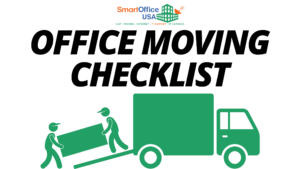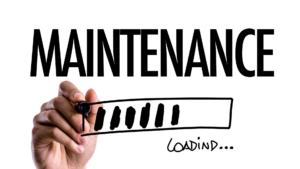
Moving into a new office is not easy. There are a lot of moving parts (no pun intended) and can stressful. SmartOffice USA has shared 11 tips for commercial moves to help business owners and employees a like stay on top of their move. Please check out our Office Moving Checklist, with 11 tips to help you with your move.
1. Don’t forget Phones/ I.T.
One of the biggest complications inherent in moving to a new office space is disconnecting and reconnecting all of your tech. As soon as you know the date of your move, have your I.T. department or a trusted phone company draft a plan for transferring all of your office’s technical equipment. This includes computers, servers, and VoIP phones, as well as your data and internet plans. This is a big job, and one that you can’t outsource to the movers, so it’s critical that your team gets to work on it as early as possible.
2. Start planning early
There’s no such thing as “winging it” when it comes to moving to a new office space. You have to start the planning process early, divvying up who will be doing what, how they’ll be doing it, and when it will be getting done. Otherwise, you may find yourself scrambling at the last minute, and nobody wants to be in the office all night throwing staplers in a box or trying to figure out how to get a dozen massive printers ready for transport.
In addition to planning how you’ll get everything ready for moving day, you’ll also want to have a plan in place for where things will go when you arrive at your new office space. Use a blueprint to figure out office and common space layouts and figure out any new needs you might have. Figure that you’ll probably have to set aside at least a few months to efficiently plan your office relocation, and a couple of months to actually get everything set up and ready to go. And don’t forget to plan ahead for your moving budget—it’s important to know how much you have to spend.
3. Appoint a move manager
Even if you’re going to be dividing up the work, it’s still important to have a designated move manager who can facilitate and follow up on each step to ensure that things are progressing. Usually the best person for this is an
administrative assistant, but you may also choose to appoint someone who has past experience with commercial relocations.
4. Do research to find the best moving company
We always recommend researching and getting quotes from at least three professional moving companies before booking your move, but because an office move can get very expensive, very fast, you’re better off looking at a couple more than that. If you have the budget for it, plan to hire a full service moving company—they’ll do all the packing for you, as well as the loading, unloading, and unpacking.
Ask around for recommendations of moving companies that have experience with office relocations, since you’ll want to make sure you only hire a company with a proven track record of success in this area. To get the most accurate quote possible, have a representative from each company come to your office and see the scope of the work. With jobs like this, it’s not enough to describe what needs to be done over the phone.
Any moving company you hire for your commercial relocation should be licensed and insured. Check out our moving company directory for a vetted list of reputable movers.
5. Assign everyone the task of packing up their own desk
While you may be having a moving company come in to take care of the big stuff, it will still be a major help to have everyone responsible for their own desk space. Give your staff a heads up on when they’ll need to have their desks packed up by, and try to encourage them to do a little bit at a time so nobody is trying to get all packed up at the last minute. You may need to just give your team a couple hours of time off on the day before the move to get their desks in order.
6. Get a handle on building rules
Unless your company owns the building you are moving out of or in to, you will need to get a full breakdown of all building rules around relocating. It may be that you are only allowed to move during non-business hours or that you must put in a special request to use the service elevator. Get these rules from building management as early as you can, since it will dictate the logistics of moving day.
7. Put address change orders in place
It’s better to start updating documents with your new address earlier rather than later, so place your orders for new business cards, letterhead, envelopes, return labels, etc. right when you know your new address. Make sure to update your clients as well, especially if they regularly ship stuff to you. It’s much better to have all of your updated documents on hand before your move than to risk going days or weeks without them in your new space.
8. Be diligent about labeling your boxes
Labeling your boxes is important in all moves, but especially when you’re moving to a new office. To keep operations running during and after the move, you’ll want to carefully label every single box so you’re not looking for things like more printer paper or toner only when you really need them. For maximum efficiency, label each box with a location and a number, and keep a corresponding spreadsheet that lists each box number and the items that are inside of it. It’s a bit more work, but it will save you a ton of time when you’re getting settled in your new location and it will be easy for everyone to access.
9. Make sure everything will fit
While you may intend to bring that massive breakroom fridge with you, the dimensions of the kitchen space in your new breakroom might not allow for it. Instead of wasting time, energy, and money on transporting items that aren’t going to work in your new office space, get the dimensions of your largest items and compare them to the measurements of your next location. This applies to things like your conference room tables, large electrical equipment, and anything else that necessitates a lot of space. Hopefully you have chosen a new office that allows for the accommodation of your existing furniture and tech, but if you haven’t, you’ll want to know that before move in—not after.
10. Try to move some non-essentials on your own first
Simplify moving day by transporting the little stuff as you can, provided there’s an overlap of timing with your new lease. You can make the whole moving process easier by taking over items like plants and bulk office supplies on your own, especially if you can get them set up in their new locations before you officially move in.
11. Celebrate your new digs
An office relocation is stressful on everyone, including your employees. As a “thank you” for everyone’s cooperation in making it happen and as a way to celebrate your new space, budget in a small party for after the move. You don’t have to be completely set up yet, and it doesn’t have to be anything major—even a mid-day celebration luncheon sometime in the first week after moving will show your staff how much you appreciate their help and welcome in exciting things at the new office.
Moving can be a lot of work, SmartOffice USA has also developed an office moving checklist worksheet to help you stay on track. Check that out as well, and distribute it throughout your office.













